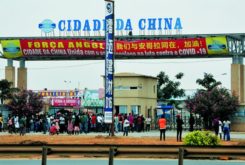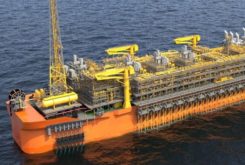The Angolan government appears determined to reform oil company Sonangol in an effort to reverse the country’s declining oil fortunes. President João Lourenço has made it clear that he intends to overhaul the firm ever since he replaced Isabel dos Santos with Carlos Saturnino as chairperson of the parastatal.The new Regeneration Program seeks to streamline Sonangol by focusing it on its core upstream operations. The changes are badly needed.
Angola produced an average of 1,417,000 b/d of crude oil in December, afall of 380,000 b/d on the second half of 2014. According to the Ministry of Mineral Resources and Oil, output could fall to 1 million b/d by 2023 if no new discoveries are developed but it wants to keep production at or around 1.4 million b/d by ensuring that existing but undeveloped deepwater finds are brought on stream.
As part of an agreement between Opec and some key non-Opec producers designed to keep oil prices between $55 and $80 a barrel, Angola is to reduce its oil production by 2%, or 29,000 b/d, from January. Unless there is a dramatic change in prices in the interim, the new Angolan quota will remain in place until the next Opec meeting in April.
Falling output is the result of a big fall in upstream exploration over the past few years. Angolan production more than doubled over the first dozen years of the new millennium, as big offshore projects were developed on the back of the revolution in deepwater technology. However, sustained low international oil prices saw upstream investment slashed in most areas but particularly on deepwater acreage, so the fact that most Angolan production is located on deepwater and ultra-deepwater fields made it particularly vulnerable.
Although the oil industry and the wider economy were in desperate need of reform, little was expected to change quickly under Lourenço when he came to power last year. However, he has acted quickly to tackle corruption and has promised deep seated economic reforms along the lines of those long demanded by the IMF. In December, the Fund agreed to lend the government $3.7 billion to help finance the economic reforms.
The President is eager to attract more foreign investment in the oil industry. While oil prices have recovered since the lows of 2014-17, they are still at levels that can best be described as moderate and so oil companies can pick and choose where they invest. Yet while oil prices have had the biggest impact on Angolan output, financial irregularities and red tape have also had an effect. Lourenço therefore knew that he had to improve the investment regime if new fields were to be brought on stream.
The new president has been fortunate in that his rise to power has coincided with the oil price recovery. Speaking in December, Saturnino said that all Angolan upstream projects would be profitable at an oil price above $61 a barrel, while Luanda’s 2019 budget is based on an average price of $68 a barrel for the year.
One sign of Sonangol’s improving finances came in December when it was revealed that it would finally receive two drill ships that had been under construction in South Korea. Daewoo Shipbuilding and Marine Engineering delayed delivery because Sonangol had been unable to pay for the purchase. However, the two have now agreed a reduced fee of $1.06 billion, down from the original price of $1.24 billion
Reorganisation of Sonangol
One of the main planks of the oil reforms is the reorganisation of Sonangol. The parastatal has always performed the role of sector regulator while being an upstream operator in its own right, effectively acting as an investor and industry referee at the same time. However, the government has now created the new National Agency of Petroleum and Gas take over regulatory roles, including responsibility for awarding concessions.
In August, Minister of Mineral Resources and Oil, Diamantino Azevedo said: “The agency will be tasked with conducting bids for new oil concessions, managing production sharing agreements, as well as representing the state in the sharing of profits from oil concessions.” Sonangol is now to focus on developing its upstream assets and its refining and distribution operations.
Sonangol is also to sell off its non-core assets, including in the agriculture, hotel, insurance, telecoms and banking sectors, and is likely to sell some of its upstream assets. The non-oil sector companies were acquired over many years, as the company was used as one of the main arms of state investment in the economy. Sonangol has already submitted a list of 52 partially or wholly owned companies to the government that will be affected.
Some are to be sold in direct sales to bidding companies, while others are to be divested in initial public offerings (IPOs) via the Angola stock exchange, which is expected to be launched by the end of 2019.They are to be sold over off the next three years, with the 25% stake in telecoms operator Unitel likely to be one of the most valuable assets. Sonangol president Carlos Saturnino said in November that the process will leave Sonangol smaller but more robust.
Partial privatisation mooted
In November, Sonangol secured $1 billion financing from a consortium of banks, including Standard Chartered and African Export-Import Bank, to fund its restructuring process.In October, the Ministry of Mineral Resources and Oil revealed that there could be an IPO to sell off a stake in Sonangol itself sometime after next June, although no decision has been made on where to list the shares. This would be a huge change for the company. After decades operating with little accountability, it would suddenly become subject to shareholder scrutiny.
Simplified oil and gas regulations are to be introduced and a new licensing round covering up to ten blocks is due in 2019, eight years after the last round was held. Sonangol is already in talks with international oil companies over many blocks. More attractive terms of investment, including lower taxes, have been offered on marginal fields – those with smaller reserves or with specific technical challenges.
Azevedo, told journalists: “We are committed to maintaining a certain balance of our production, in creating the environment so that there is more investment in Angola, essentially in exploration.” That maintenance figure is around 1.5 million b/d.
It is also possible that the new government’s approach could pay dividends in the gas sector. With a limited domestic market for natural gas, beyond a solitary LNG train, limited effort has been put into developing gas fields, exploring for gas or appraising the size of existing gas finds.
Most of Angola’s production sharing contracts only relate to oil and not gas, leaving Sonangol in theoretical control of gas finds, although it has done little to date to develop many of them. This is now set to change, with upstream investors given control of all hydrocarbon discoveries on their blocks. Luanda’s new found enthusiasm for the commodity was underlined by its decision to formally join the Gas Exporting Countries Forum this year.
The reorganisation of parastatal responsibilities is due to be completed in 2020. Visiting Angola in December, Opec secretary general Mohammad Sanusi Barkindo said: “These are the right reforms at the right time. We at OPEC applaud these reforms.”
New investment
There has been some investment in new projects, even during the lean years of low oil prices. Total produced first oil on its Kaombo project in 2018 and expects output to reach 230,000 b/d during the course of 2019. The French firm has also announced plans to produce 40,000 b/d on the Zinia 2 project.
In December, Eni revealed that it had made a new oil discovery, named Afoxe, on its Block 15/06 and close to the existing Kalimba find. Its initial estimate is of 170-200 million barrels of crude oil but several more wells will be drilled during the course of 2019 to ascertain the size of the field. Sonangol holds a 36.84% stake in the concession. Eni began production on the Vandumbu field on the same block in late 2018, adding 20,000 b/d of output.
Two important deals were announced in December. First, BP signed an agreement with Sonangol to develop the Platina field on Block 18 and extend its licence for the Greater Plutonio project on the same block, which came on stream in 2007, until 2032. The final investment decision on Platina is due in the second quarter of 2019.The two firms also signed a preliminary agreement on further exploration on blocks 18 and 31.
Companies and governments invariably praise each other in official statements on such occasions but the tone of BP CEO Bob Dudley’s statement suggests that the government has genuinely begun to adopt a more pro-business attitude. He said that he “would like to thank President Lourenço, the government and Sonangol for their vision, leadership and drive to improve the industry’s competitiveness and encourage new investment.”Similarly, the general manager of ExxonMobil in Angola, Andre Kostelnik, said that “2018 was marked by many promises and changes that are welcome”.
At the other end of the oil production chain, Total and Sonangol have agreed to set up a joint fuel distribution, storage and retail business under the Total brand using both domestic and imported refined petroleum products. They will utilise 45 of Sonangol’s existing service stations and expand the network.
There is no guarantee that the planned reforms will actually be enacted. Many of them were announced by the dos Santos government but never put into practice. While Lourenço has made a good start and certainly talks the talk on reform, there is a lot to do to transform Sonangol into a thriving, proactive oil company, particularly in terms of paying down its debt levels.



